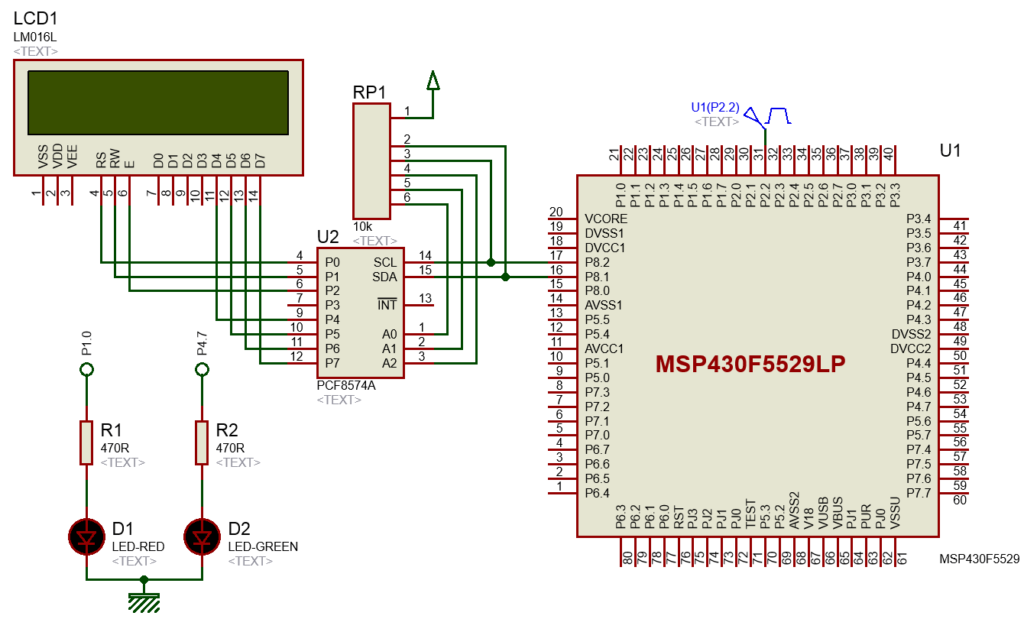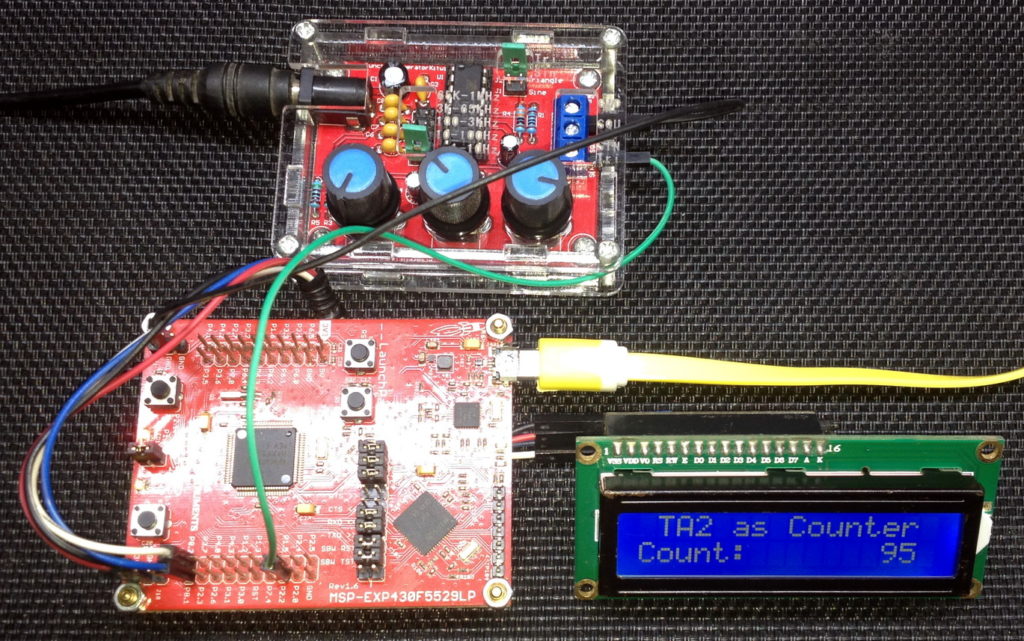Tinkering TI MSP430F5529

|
|
Timer as Counter – TA2
When the clock source of a timer is both regular and repetitive, the timer can be used for tracking/keeping time. When the same timer is fed with an irregular source, the timer acts like a counter. In both cases, pulses are counted – one in synchronous while the other is asynchronous. We can make software-based counters by incrementing/decrementing variables. However, we can do this on hardware level if we use timers as counters and feed them with external inputs.
Code Example
#include "driverlib.h"
#include "delay.h"
#include "lcd.h"
#include "lcd_print.h"
void clock_init(void);
void GPIO_init(void);
void timer_T2A3_init(void);
void main(void)
{
signed int value = 0;
WDT_A_hold(WDT_A_BASE);
clock_init();
GPIO_init();
timer_T2A3_init();
LCD_init();
LCD_clear_home();
LCD_goto(1, 0);
LCD_putstr("TA2 as Counter");
LCD_goto(0, 1);
LCD_putstr("Count:");
while(true)
{
value = Timer_A_getCounterValue(TIMER_A2_BASE);
print_C(12, 1, value);
if((value > 20) && (value 40) && (value 60) && (value < 120))
{
GPIO_setOutputHighOnPin(GPIO_PORT_P1,
GPIO_PIN0);
GPIO_setOutputHighOnPin(GPIO_PORT_P4,
GPIO_PIN7);
}
else
{
GPIO_setOutputLowOnPin(GPIO_PORT_P1,
GPIO_PIN0);
GPIO_setOutputLowOnPin(GPIO_PORT_P4,
GPIO_PIN7);
}
};
}
void clock_init(void)
{
PMM_setVCore(PMM_CORE_LEVEL_3);
GPIO_setAsPeripheralModuleFunctionInputPin(GPIO_PORT_P5,
(GPIO_PIN4 | GPIO_PIN2));
GPIO_setAsPeripheralModuleFunctionOutputPin(GPIO_PORT_P5,
(GPIO_PIN5 | GPIO_PIN3));
UCS_setExternalClockSource(XT1_FREQ,
XT2_FREQ);
UCS_turnOnXT2(UCS_XT2_DRIVE_4MHZ_8MHZ);
UCS_turnOnLFXT1(UCS_XT1_DRIVE_0,
UCS_XCAP_3);
UCS_initClockSignal(UCS_MCLK,
UCS_XT2CLK_SELECT,
UCS_CLOCK_DIVIDER_1);
UCS_initClockSignal(UCS_SMCLK,
UCS_XT2CLK_SELECT,
UCS_CLOCK_DIVIDER_4);
UCS_initClockSignal(UCS_ACLK,
UCS_XT1CLK_SELECT,
UCS_CLOCK_DIVIDER_1);
}
void GPIO_init(void)
{
GPIO_setAsPeripheralModuleFunctionInputPin(GPIO_PORT_P2,
GPIO_PIN2);
GPIO_setAsOutputPin(GPIO_PORT_P1,
GPIO_PIN0);
GPIO_setAsOutputPin(GPIO_PORT_P4,
GPIO_PIN7);
}
void timer_T2A3_init(void)
{
Timer_A_initUpModeParam UpModeParam = {0};
UpModeParam.clockSource = TIMER_A_CLOCKSOURCE_EXTERNAL_TXCLK;
UpModeParam.clockSourceDivider = TIMER_A_CLOCKSOURCE_DIVIDER_1;
UpModeParam.timerPeriod = 120;
UpModeParam.timerInterruptEnable_TAIE = TIMER_A_TAIE_INTERRUPT_DISABLE;
UpModeParam.captureCompareInterruptEnable_CCR0_CCIE = TIMER_A_CCIE_CCR0_INTERRUPT_DISABLE;
UpModeParam.timerClear = TIMER_A_SKIP_CLEAR;
UpModeParam.startTimer = true;
Timer_A_stop(TIMER_A2_BASE);
Timer_A_clearTimerInterrupt(TIMER_A2_BASE);
Timer_A_initUpMode(TIMER_A2_BASE,
&UpModeParam);
}
Hardware Setup

Explanation
Here timer T2A3 is used to count incoming pulses. Since counting pulses involves timer’s external input pin, this input pin must be declared as an Input Peripheral Module Function pin.
GPIO_setAsPeripheralModuleFunctionInputPin(GPIO_PORT_P2, GPIO_PIN2);Timer TA2 is setup as follows:
void timer_T2A3_init(void)
{
Timer_A_initUpModeParam UpModeParam = {0};
UpModeParam.clockSource = TIMER_A_CLOCKSOURCE_EXTERNAL_TXCLK;
UpModeParam.clockSourceDivider = TIMER_A_CLOCKSOURCE_DIVIDER_1;
UpModeParam.timerPeriod = 120;
UpModeParam.timerInterruptEnable_TAIE = TIMER_A_TAIE_INTERRUPT_DISABLE;
UpModeParam.captureCompareInterruptEnable_CCR0_CCIE = TIMER_A_CCIE_CCR0_INTERRUPT_DISABLE;
UpModeParam.timerClear = TIMER_A_SKIP_CLEAR;
UpModeParam.startTimer = true;
Timer_A_stop(TIMER_A2_BASE);
Timer_A_clearTimerInterrupt(TIMER_A2_BASE);
Timer_A_initUpMode(TIMER_A2_BASE, &UpModeParam);
}
Clock source is the very first thing to note in this example. ACLK or SMCLK is not used. Externally clock pulses are applied via timer input pin. Note however timer input pin is also not a CC channel pin.
Up mode counting is used with a top value of 120 and so the timer will count from 0 to 120 and then roll over.
Interrupts are avoided and so polling method is used.
Initially, the timer is kept in halt state and timer settings are not cleared because no setting was applied beforehand.
After setting up the timer, the timer is started but counting doesn’t start until there is a logic transition in the timer’s external input pin. Each incoming pulse increases the timer’s count.
In the main loop, timer’s count is checked or polled on each loop passes. The value of timer count is displayed on an LCD and -LEDs are flashed according to count values.
value = Timer_A_getCounterValue(TIMER_A2_BASE);
print_C(12, 1, value);
if((value > 20) && (value 40) && (value 60) && (value < 120))
{
GPIO_setOutputHighOnPin(GPIO_PORT_P1, GPIO_PIN0);
GPIO_setOutputHighOnPin(GPIO_PORT_P4, GPIO_PIN7);
}
else
{
GPIO_setOutputLowOnPin(GPIO_PORT_P1, GPIO_PIN0);
GPIO_setOutputLowOnPin(GPIO_PORT_P4, GPIO_PIN7);
}
Demo

|
|
Hi,
Im interfacing MSP430F5529 with MAX17055 fuel guage. while reading 16 bit value, the first byte im receiving is 0. so while reading multiple registers continuously the data exchange is happening, but im getting the correct data. Can anyone suggest me what will be the issue? why im getting 0 in first byte?
read16_bit data code:
uint16_t value = 0;
USCI_B_I2C_setslaveaddress(USCI_B1_BASE, slave_address);
USCI_B_I2C_setmode(USCI_B1_BASE, USCI_B_I2C_TRANSMIT_MODE);
USCI_B_I2C_masterSendStart(USCI_B1_BASE);
while (!USCI_B_I2C_masterSendStart(USCI_B1_BASE));
USCI_B_I2C_mastterSendSingleByte(USCI_B1_BASE, reg_address);
USCI_B_I2C_setslaveaddress(USCI_B1_BASE, slave_address);
USCI_B_I2C_setmode(USCI_B1_BASE, USCI_B_I2C_TRANSMIT_MODE);
USCI_B_I2C_masterReceiveMultiByteStart(USCI_B1_BASE);
uint8_t lb = USCI_B_I2C_masterReceiveMultiByteNext(USCI_B1_BASE);
uint8_t hb = USCI_B_I2C_masterReceiveMultiByteFinish(USCI_B1_BASE);
while (USCI_B_I2C_isBusBusy(USCI_B_BASE));
value = lb << 8;
value |= hb;
return value;
In code, after sending reg address, it will be recieve mode. its a type mistake
Hi, im trying to send the command from the terminal view. i can able to send the command and tried to blink p1.0 led in msp430f5529 controller, its working fine. And im using led driver IS31FL3236A interfaced with msp430f5529 controller, i can able to interface im getting the expected output.
now i need to send the command from seriak monitor based on that command i2c communication need to start. both communication are working fine, when it runs separately. its not working when i tried to combine.
any one had any idea, why it is happening or what will be the issue?
It could be due to:
1. conflicts in clock settings
2. hardware conflict like pin mapping
3. code is getting stuck or waiting for one communication line to finish
4. use of polling method instead of interrupt-driven coding
Hi, thank you for the respose.
Do I need to use different clock initialization for I2C and UART communication? if YES, can you explain how to do that?
I mean check which clock has been set for UART and I2C…. Is it SMCLK, MCLK, etc and is it tuned to right frequency required by the respective hardware?
Is there any example on how to implement polling method in uart?
Why go for polling method when it is a blocking method of coding? It is better to use interrupts instead at least for UART receive.
yes!! currently in my code, only for uart im using interrupts to recieve command from serial monitor. Im not using interrupt for I2C communication.
so the issue is must be in clock initialization. right?
For UART, im using USCI_A1_BASE. and for I2C, im using USCI_B1_BASE.
And another thing i need to ask is, in uart when i tried blink led(p1.0) in msp430f5529 by passing command. here, without clock I’m getting output. how it is possible?
And for both i2c and uart i gave SMCLK with 1Mhz
I am surprised and happy to find this tutorial on the F5529 as TI makes a lot of different devices.
Thank you very much for putting in the extra knowledge in each segment, made reading worthwhile.
Good Work!
lovely tutorial but to be honest I don’t think I’d be investing my time on this board to start with it’s not cheap and readily available as the stm32 boards can you please do more tutorials on stm32 board’s and the stc micros thanks
Hello, I try to program MSP430FR6047 but i get error “the debug interface to the device has been secured”. when flashing using uniflash and when program using CCS this happen. can you help me to solve this problem
You can try “On connect, erase user code and unlock the device” option.
Pingback: Tinkering TI MSP430F5529 – gStore
Hello
I am doing project of msp430g2553 interface(using i2c communication) with temp 100(temperature sensor) and try to read the temperature in dispaly(16*2) but didn’t get the out put (using code composer studio) can u share me any example code for this project
Thank you sir,
Which sensor? Did you use pullup resistors for SDA-SCL pins?
Where is lcd_print.h?
All files and docs are here:
https://libstock.mikroe.com/projects/view/3233/tinkering-ti-msp430f5529
You want the truth? TI makes and sell “underpowered micros”, you know? Low everything, not only the power but also peripherals. So the price is not justified.
Otherwise, if I’ll move there, I’ll introduce them to my small hobby projects – there are still some advantages.
I may even make a visual configuration tool of my own for them…
Yeah the prices of TI products are higher than other manufacturers but I don’t think the hardware peripherals are inferior.
Not inferior but in not enough numbers compared to STM32.
True